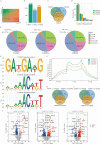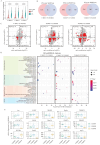Integrated m6A RNA methylation and transcriptomic analysis of Apostichopus japonicus under combined high-temperature and hypoxia stress
- PMID: 40211154
- PMCID: PMC11987279
- DOI: 10.1186/s12864-025-11532-x
Integrated m6A RNA methylation and transcriptomic analysis of Apostichopus japonicus under combined high-temperature and hypoxia stress
Abstract
Background: Global climate change has significantly increased environmental stress in marine ecosystems, with rising sea surface temperatures and declining dissolved oxygen (DO) levels. These stressors pose critical challenges to aquaculture, particularly for Apostichopus japonicus, an economically significant species in China. A. japonicus is highly sensitive to combined high-temperature and hypoxia stress, which disrupts physiological processes, suppresses immune responses, and increases mortality. While epigenetic mechanisms such as N6-methyladenosine (m6A) RNA modifications are known to regulate stress adaptation, their role under dual stressors in A. japonicus remains poorly understood.
Results: This study integrates m6A methylation sequencing (MeRIP-seq) and transcriptomic analysis (RNA-seq) to investigate molecular responses in A. japonicus under combined high-temperature (32 °C) and hypoxia (DO = 2 mg/L). Results show that approximately 90% of genes had 1-3 m6A peaks, with single peaks being the most frequent (∼ 60%). Genes with m6A modifications exhibited varying expression levels, with some showing significantly higher expression, suggesting a complex relationship between m6A methylation and stress-responsive gene expression. GO and KEGG enrichment analyses revealed that m6A-modified genes regulate pathways associated with oxidative stress, protein homeostasis, and energy metabolism, such as the PI3K-Akt and MAPK signaling pathways. Key stress-responsive genes, including HSP70, NOX5, and SLC7A11, exhibited dynamic m6A methylation changes, highlighting their roles in redox homeostasis and cellular resilience. Comparative analysis across experimental groups revealed distinct molecular responses to hypoxia, high-temperature stress, and their combination, with combined stress inducing more pronounced changes in m6A methylation and gene expression.
Conclusion: In this study, we explored the central regulatory role of m6A RNA methylation in the response of A. japonicus to the dual environmental stress of high-temperature and hypoxia. The findings show that m6A modification regulates the expression of key genes, allowing A. japonicus to effectively adapt to harsh environmental conditions. This study not only provides an important new perspective on the molecular stress recovery mechanism of marine invertebrates in the face of complex environmental stress, but it also provides theoretical support for aquaculture practice, assisting in the development of more stress-resistant aquaculture systems to deal with the severe challenges posed by global climate change.
Keywords: Apostichopus japonicus; High-temperature stress; Hypoxia stress; Stress adaptation mechanisms; m6A RNA methylation.
© 2025. The Author(s).
Conflict of interest statement
Declarations. Ethics approval and consent to participate: The animal study was approved by the Institutional Animal Care and Use Committee of the Ludong University (protocol number LDU-IRB20210308NXY). The study was conducted in accordance with the local legislation and institutional requirements. Consent for publication: Not applicable. Competing interests: The authors declare no competing interests.
Figures




Similar articles
-
Transcriptome-wide methylated RNA immunoprecipitation sequencing profiling reveals m6A modification involved in response to heat stress in Apostichopus japonicus.BMC Genomics. 2024 Nov 11;25(1):1071. doi: 10.1186/s12864-024-10972-1. BMC Genomics. 2024. PMID: 39528936 Free PMC article.
-
Transcriptome-wide identification and analysis reveals m6A regulation of metabolic reprogramming in shrimp (Marsupenaeus japonicus) under virus infection.BMC Genomics. 2024 Nov 19;25(1):1103. doi: 10.1186/s12864-024-11032-4. BMC Genomics. 2024. PMID: 39563253 Free PMC article.
-
Transcriptome-wide m6A methylation profile reveals its potential role underlying drought response in wheat (Triticum aestivum L.).Planta. 2024 Jul 29;260(3):65. doi: 10.1007/s00425-024-04491-2. Planta. 2024. PMID: 39073585
-
The epigenetic approach of varicocele: a focus on sperm DNA and m6A-RNA methylation.Hum Reprod Update. 2025 Mar 1;31(2):81-101. doi: 10.1093/humupd/dmae034. Hum Reprod Update. 2025. PMID: 39673728 Review.
-
The landscape of N 6-methyladenosine RNA methylation in skin diseases.Br J Dermatol. 2025 May 19;192(6):983-994. doi: 10.1093/bjd/ljaf087. Br J Dermatol. 2025. PMID: 40059697 Review.
References
-
- Li Y, et al. High-quality sea surface temperature measurements along Coast of the Bohai and yellow seas in China and their long‐term trends during 1960–2012. Int J Climatol. 2019;40:63–76.
-
- Shi W, Wang M. Satellite views of the Bohai Sea, yellow Sea, and East China Sea - ScienceDirect. Prog Oceanogr. 2012;104(10):30–45.
-
- Chen Y, et al. Seasonal variability in dissolved oxygen in the Bohai Sea, China. J Oceanol Limnol. 2022;40(1):78–92.
-
- Yang F, et al. Nitrogen from agriculture and temperature as the major drivers of deoxygenation in the central Bohai sea. Sci Total Environ. 2023;893:164614. - PubMed
-
- Kang B, et al. Climate change impacts on China’s marine ecosystems. Rev Fish Biol Fish. 2021;31:599–629.
MeSH terms
Substances
Grants and funding
LinkOut - more resources
Full Text Sources

